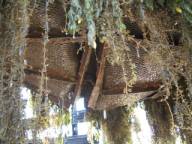Thursday July 6
The day shift began with Operations monitoring store 4813 and a Recycler stash, with the Collider Detector at Fermilab (CDF) and D-Zero (D0) using the colliding beam store, with the Antiproton Source (Pbar) stacking, with the Linac, Booster, Main Injector (MI), and Recycler operating normally, with NuMI off due to a horn cooling problem, and with MiniBooNE taking beam.
FESS technicians reported at 9:53 AM that they had begun the cleanout of the Tevatron (TeV) sector A0 pond strainer. Below are pictures of the work.
  
The Meson MTest experiment began taking beam a little after 11 AM.
At 12:10 PM, D0 experimenters reported that their toroid had developed a small LCW leak. They don’t need an access to repair the leak.
Operations prepared the Recycler at 12:16 PM to stash antiprotons. The stash ended and Pbar resumed stacking.
Operations terminated store 4813 at 1:02 PM.
TeV experts began their study period at 1:30 PM.
Operations put the TeV into shot setup at 3:15 PM.
At 3:51 PM, a Switchyard (SY) power supply (VH94) developed a small LCW leak. Techs began repairs. This work held off MTest beam.
Operations established store 4815 at 5:16 PM with an initial luminosity of 139.89E30. Operations reported that Pbar had resumed stacking about fifteen minutes before the store was established with no ill effects.
At 5:41 PM, an expert began working on the QXR. MTest experimenters reported that they would be working in their hall for the rest of the evening: no beam.
The Recycler began preparing to stash at 7:06 PM. The stash ended and Pbar resumed stacking at 7:52 PM.
Friday July 7
The midnight shift began with Operations monitoring store 4815 and the stash, with Pbar stacking, and with MiniBooNE taking beam.
The Recycler began preparing to stash at 12:25 AM. The stash ended and Pbar resumed stacking at 12:57 AM.
The Recycler began preparing to stash at 5:12 AM. The stash ended and Pbar resumed stacking at 5:47 AM.
Operators search and secured the MTest experiment at 7:33 AM.
The Plans for Friday and the Weekend
The plans for today and the weekend are to stack, stash, and store.
MACHINE REPORTS
Linac
Linac Running Between June 30 and July 6, 2006
- Running on the H- Ion Source
- Beam Current 38 ma
Downtime - 3.76 Hours With 17 Occurrences
Major Sources of Downtime
- .92 hr. - KRF4 Filament timeout
- 2.67 hr. - two low energy Linac quad timing pulse repeaters failed
Problems
- Other than those that caused downtime, there weren’t any problems
Booster
June 30 – July 7
- Stacking: 8 – 10 Turns with ~3.5 to 4E12/batch
- MiniBooNE: 8 Turns – Protons/Pulse at ~4.8E16/hr
- NuMI: Off
Studies
- Tuning
- Efficiency never recovered after Linac retune?
- Looking at 400 MeV wires and beam positions
- Mode 47 damper phasing
- Beam position problems on high intensity cogged cycles
- RF balancing work nearly complete
- Gamma t studies continue
- Preaccelerator notching enabled for $1D cycles and synched with the Booster notch pulse width tuning
- Tested ORBMP foils and switched to a lower density foil
Downtime: 3 hours
- MKS05 shorted cable took 2 hours to repair
- RF miscellaneous work 0.5 hours
- ORBMP work 0.5 hours
Access: 6 hours
Next Week
- Continue to work on Preacc notching $1D
- Push higher intensity - no NuMI
- Damper work - higher intensity
- Injection tunes/orbit work
- Continue Gamma t
Main Injector
MI
- Coalescing
- 86% large antiproton stash from Recycler
- Mini-dip bend field
- 120 Slow spill
- Establish 4 second slow spill
- Problem with I68 program identified
LINUX certification continues...
- I50, Orbit smoothing program
- I52, Orbit closure program
BPM upgrade
- Next is MI60 South
- Orbit closure for reverse proton from TEV
- Use injection frame from the new BPM system
- BLT style closure program
Antiproton Source
Stacking
- Stacking rate is ~15% lower than it should be for our present intensity on target
- Beam to the end of AP2 and circulating in the Debuncher is as good as it was before the shutdown
- Beam injected into the Accumulator is ~15% below what it should be for the present intensity on target
- It appears that our bottleneck is in the D to A transfer
Beam Studies
- This week:
- Yield and D-A beam size vs. cycle time
- Began centering stacktail kicker tanks
- Major streamlining of Pbar-Recycler sequencer aggregates
- The near future:
- Repeat and improve on yield/beam size vs. cycle time study
- Continue stacktail kicker centering
- Studies to make the AP2 portion of the “Overthruster” operational
Work List
- QS732 Repair
- 4-8 GHz core ∆p cooling gain change
- Debuncher Tank 201 feed through installation (1½ to 2 day shutdown)
- Dead high level amplifier stage in core vertical band 1 cooling
- TOR724 noise reduction
- Target stack exhaust fan trouble shoot (requires pre-target access)
Recycler
Apparent Problems
- Transverse emittance growth during mining/extraction (>100%)
- Longitudinal emittance dilution during RF manipulation (~15%)
- Uneven bunch intensity due to RF distortion (~100%)
Transverse Emittance
- Transverse emittances grow after momentum mining RF appears
- Only happens with antiprotons cooled by electron beam and stochastic cooling
- Only happens when there is high density
- Factors of 2~3 increase
- We have not totally understood the cause due to operational considerations
- Solutions:
- Speed up momentum mining
- Do not use momentum mining
- Change tunes
- Remove electron beam during mining/extraction?
Longitudinal Emittance Dilution During RF Manipulation
- From stretching a barrier bucket containing cold beam
- Due to very slow synchrotron frequency of particles in a barrier and finite speed of manipulation
- Solution: change extraction algorithm to raise synchrotron frequencies
- Bucket “accordionation”
- “Strip mining”
Bunch Unevenness
- Caused by potential well distortion
- Proof based on cavity fan back voltage
- Solution:
- Feedback correction
- In progress by Instrumentation/Recycler
- Fast response compared to speed of RF manipulation
Conclusion
- We should be able to further improve the Recycler performance
- Transverse growth during mining is the least understood
- Need to coordinate more non-destructive studies
- RF feedback looks hopeful; may be operational in a few months
Tevatron
Store Summary
Store |
Avg. Init. Lum (E30) |
Avg. Deliv’d
Lum
(nb -1) |
Time (hr) |
How did it end? |
Comments |
4815 |
139.5 |
|
|
Running |
Tune adjust at LEBSQ=2; Tune tracker phase adjustment; New Linux version of orbit stabilization test and in operation |
4813 |
132.5 |
1259 |
32.5 |
Intentional |
Tune tracker need tuning |
4812 |
115.1 |
4825 |
33.6 |
Intentional |
After quench recovery and damper check up; HF22 @ wrong value |
4808 |
119.7 |
4718 |
28.0 |
Intentional |
Antiproton tune lowered to minimize emittance “scallops”; HF22 @ wrong value |
4805 |
141.4 |
4966 |
21.7 |
Abort |
BQ9 Firing card problem; 1.7GHz Schottky problem |
Machine Maintenance Studies
- Machine tuning ups and optimization
- Tune tracker phase tuning
- Damper checkups
- Orbit stabilization program test
- New Linux version with improved features
Problems
- Lost store due to BQ9 firing card
- Quench during cogging
- Beam position problems at F48U due to HF22 at wrong value
- 1.7GHz Schottky tune meter;
- Tunes low through squeeze
Study Requests
- Proton bumper timing adjustment:
- A0 beam abort position adjustment:
- Tune adjustment for squeeze
- TEL2 orbit and timing tuning, modulator test
- Available proton only times
Switchyard
Summary
- Friday - Sunday
- T956 (ILC muon) low intensity 120 GeV protons ~10K per pulse 12am to 12 pm
- Monday - Tuesday T927 (CMS Pixel)
- started in proton mode 9am - 9pm
- Friday – Tuesday
- uptime ~50% of 12 hour intervals
- Wednesday -Thursday
- Slow spill length modified from 1 sec to 4 sec at T927’s request, also request for ~100K in 120 GeV proton mode (Slow spill working need to check tune SY with 4 sec spill)
Unofficial MTest Beam Uptime
- 70 hours requested, 40 received ~60%
- 4 hours lost to PS Meson Front End,
- P3 line - HP3DS PS intermittent problems
NuMI
Horn 1 Clogged Up with D. I. Bottle Resin Beads
- Had been having problem with water collecting in tank under horn 1 instead of coming back to surge tank and had more than normal amount of water in system.
- On Friday, tried to drain some water out of the surge tank, hoping that would allow more water to come back from horn collection tank.
- Techs turned off the supply line to horn spray, letting ejector pump continue to take water out of horn collection tank. This also cut off pressure to the D.I bottle loop that cleans water, keeping resistivity high.
- Spray line draining to horn sucked water backwards through the D.I. Loop, pulling resin beads into the supply line to the horn.
- When horn supply line was turned back on, resin beads got into the horn supply line and clogged the spray lines.
- Check valve that should have prevented this was mounted upside down. Also, spring-loaded check valve would have made more sense.
Clean-up of water skid is fairly straight-forward
- Over weekend, tried test of pushing resin beads out of spare nozzles by back-pressure with water, with reasonable success
- Monday/Tuesday, tried on test-bench vacuuming beads out with air pressure instead of water. Are starting with this method on horn
- Wednesday, removed target pile shielding. Now doing vacuuming – have sucked some resin beads out and unclogged at least a few nozzles
- If horn clean-up works smoothly, estimate ~ 2 weeks downtime
- If horn clean-up fails, need to replace horn
- A horn change-out takes ~ 1 week, but spare not ready for at least 8 weeks
Accelerator Update Archive
More Information
For Tevatron luminosity charts and the current status of Fermilab's accelerators and detectors (live!), please go to Fermilab Now.
Comments and Suggestions
What do you think about the Accelerator Updates? Please send comments and suggestions to: accelupdates@fnal.gov.

|